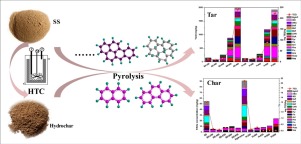当前位置:
X-MOL 学术
›
J. Anal. Appl. Pyrol.
›
论文详情
Our official English website, www.x-mol.net, welcomes your feedback! (Note: you will need to create a separate account there.)
Identification and quantification of polycyclic aromatic hydrocarbons generated during pyrolysis of sewage sludge: effect of hydrothermal carbonization pretreatment
Journal of Analytical and Applied Pyrolysis ( IF 6 ) Pub Date : 2018-03-01 , DOI: 10.1016/j.jaap.2018.01.021 Tingting Liu , Yanchuan Guo , Nana Peng , Qianqian Lang , Yu Xia , Chao Gai , Qingfu Zheng , Zhengang Liu
Journal of Analytical and Applied Pyrolysis ( IF 6 ) Pub Date : 2018-03-01 , DOI: 10.1016/j.jaap.2018.01.021 Tingting Liu , Yanchuan Guo , Nana Peng , Qianqian Lang , Yu Xia , Chao Gai , Qingfu Zheng , Zhengang Liu

|
Abstract Hydrothermal carbonization (HTC) is of increasing importance to improve fuel quality and dewaterability of sewage sludge (SS). In this study, the effect of HTC of SS on the formation of 16 priority polycyclic aromatic hydrocarbons (PAHs) during pyrolysis, the primary stage of combustion, were investigated. The results showed that HTC improved fuel quality of SS while the PAHs were concentrated in the resultant hydrochar. Hydrochar pyrolysis generated less tar (3.49–8.82%) than SS pyrolysis (4.73–14.83%) while the PAHs yields in hydrochar pyrolytic tar were higher than the yields of SS pyrolytic tar, ranging from 104.93 mg/kg to 1199.07 mg/kg in the temperature range of 500–800 °C. In addition, the proportions of highly toxic middle molecular weight (MMW) and high molecular weight (HMW) PAHs in hydrochar tar were much higher than that for SS. As for the pyrolytic char, the PAHs in hydrochar char were also far higher than that in SS pyrolytic char at the temperature higher than 650 °C. These differences resulted in more total PAHs emissions and higher toxic equivalent quantity (TEQ) from hydrochar pyrolysis than those from SS pyrolysis in the temperature range of 500–800 °C. This study indicated that more attention should be paid to control PAHs emission energy recovery from hydrothermally treated SS.
中文翻译:

污水污泥热解过程中产生的多环芳烃的鉴定和定量:水热碳化预处理的影响
摘要 水热碳化(HTC)对于改善污水污泥(SS)的燃料质量和脱水性越来越重要。在这项研究中,研究了 SS 的 HTC 在热解(燃烧的初级阶段)过程中对 16 种优先多环芳烃 (PAH) 形成的影响。结果表明,HTC 提高了 SS 的燃料质量,而 PAHs 集中在所得的氢化碳中。Hydrochar 热解产生的焦油 (3.49–8.82%) 比 SS 热解 (4.73–14.83%) 少,而 Hydrochar 热解焦油中 PAHs 的产量高于 SS 热解焦油的产量,范围从 104.93 mg/kg 到 1199.07 mg/kg。温度范围为 500–800 °C。此外,氢化焦油中剧毒中分子量(MMW)和高分子量(HMW)多环芳烃的比例远高于SS。至于热解焦,在高于 650 ℃的温度下,氢化炭中的 PAHs 也远高于 SS 热解焦。在 500-800 °C 的温度范围内,这些差异导致加氢碳热解产生的多环芳烃总排放量和毒性当量 (TEQ) 高于 SS 热解产生的多环芳烃排放量和毒性当量 (TEQ)。该研究表明,应更加关注控制水热处理SS的PAHs排放能量回收。在 500–800 °C 的温度范围内,这些差异导致加氢炭热解产生的多环芳烃总排放量和毒性当量 (TEQ) 高于 SS 热解产生的排放量。该研究表明,应更加关注控制水热处理SS的PAHs排放能量回收。在 500-800 °C 的温度范围内,这些差异导致加氢碳热解产生的多环芳烃总排放量和毒性当量 (TEQ) 高于 SS 热解产生的多环芳烃排放量和毒性当量 (TEQ)。该研究表明,应更加关注控制水热处理SS的PAHs排放能量回收。
更新日期:2018-03-01
中文翻译:

污水污泥热解过程中产生的多环芳烃的鉴定和定量:水热碳化预处理的影响
摘要 水热碳化(HTC)对于改善污水污泥(SS)的燃料质量和脱水性越来越重要。在这项研究中,研究了 SS 的 HTC 在热解(燃烧的初级阶段)过程中对 16 种优先多环芳烃 (PAH) 形成的影响。结果表明,HTC 提高了 SS 的燃料质量,而 PAHs 集中在所得的氢化碳中。Hydrochar 热解产生的焦油 (3.49–8.82%) 比 SS 热解 (4.73–14.83%) 少,而 Hydrochar 热解焦油中 PAHs 的产量高于 SS 热解焦油的产量,范围从 104.93 mg/kg 到 1199.07 mg/kg。温度范围为 500–800 °C。此外,氢化焦油中剧毒中分子量(MMW)和高分子量(HMW)多环芳烃的比例远高于SS。至于热解焦,在高于 650 ℃的温度下,氢化炭中的 PAHs 也远高于 SS 热解焦。在 500-800 °C 的温度范围内,这些差异导致加氢碳热解产生的多环芳烃总排放量和毒性当量 (TEQ) 高于 SS 热解产生的多环芳烃排放量和毒性当量 (TEQ)。该研究表明,应更加关注控制水热处理SS的PAHs排放能量回收。在 500–800 °C 的温度范围内,这些差异导致加氢炭热解产生的多环芳烃总排放量和毒性当量 (TEQ) 高于 SS 热解产生的排放量。该研究表明,应更加关注控制水热处理SS的PAHs排放能量回收。在 500-800 °C 的温度范围内,这些差异导致加氢碳热解产生的多环芳烃总排放量和毒性当量 (TEQ) 高于 SS 热解产生的多环芳烃排放量和毒性当量 (TEQ)。该研究表明,应更加关注控制水热处理SS的PAHs排放能量回收。



























 京公网安备 11010802027423号
京公网安备 11010802027423号